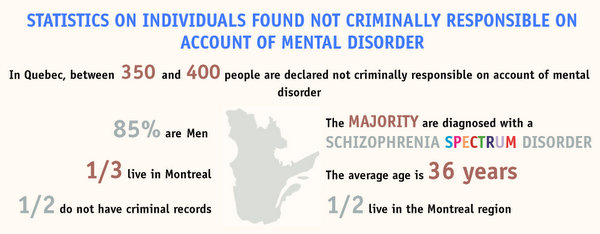Dating as far back as 1772 BCE when the Code of Hammurabi – one of humanity’s oldest known legal codes – came to be, the criminal justice system has run on a punitive, reactive model. A crime is committed, the perpetrator is captured, and a sentence befitting the crime is given. Legal systems have, for a long time, operated under the general assumption that individuals are responsible for their actions.
Scientific studies on criminality have begun to shed light on the fact that the question of criminal responsibility is not so black and white. Genetic and environmental factors shape our biology, and determine the person we become. For some, these factors lead to a greater vulnerability to commit criminal action. This knowledge begs the question: to what extent are criminals responsible for their behaviour?
Consider Charles Whitman – a Texan man who in the span of two days killed his wife and mother and went on a mass shooting rampage, killing 17 and injuring many more. The night before the massacre, Whitman sat at a typewriter and wrote this letter:
“I don’t really understand myself these days. I am supposed to be an average reasonable and intelligent young man. However, lately (I can’t recall when it started) I have been a victim of many unusual and irrational thoughts […] after my death I wish that an autopsy would be performed to see if there is any visible physical disorder.”
Whitman himself was at a loss to explain his sudden violent behaviour. As per his wishes, an autopsy was performed. When medical examiners opened Whitman’s skull, they found a nickel-sized tumor affecting several of his brain regions, most notably the amygdala – a region known to be involved in emotional regulation. Cases like Whitman’s are rare, but they provide evidence that individuals do not always possess the free will to act as they please.
Criminal responsibility and the brain
Under Section 16 of the Canadian Criminal Code, individuals who commit a crime without the capacity to understand its wrongful nature are deemed not criminally responsible for their actions. Those who fall under the Code’s definition of not criminally responsible (NCR) generally only include a select group of individuals who have a mental illness or are severely medicated at the time of the trial.
Criminal responsibility runs under the presumption that criminals are autonomous, rational decision makers; however, advancements in studies on decision making by neuroscientists such as Daeyeol Lee at Yale University and Michael Shadlen at Columbia University are shedding light on the fact that decisions people make may not, in fact, be as autonomous as once believed.
The field of neuroscience and law – known as neurolaw – seeks to bring neuroscientific findings to the courtroom. Neuroscientists and psychologists are working to understand how social and biological factors shape our brains in order to identify predictors of criminality. It is known that genetic and environmental factors play a role in shaping people’s brains and their decisions, and some of these lead to higher predispositions for criminal behaviour.
In The Atlantic, David Eagleman, a neuroscientist who directs the Initiative for Neuroscience and Law at the Baylor College of Medicine, describes genetic predispositions to crime: “If you are a carrier of a particular set of genes, the probability that you will commit a violent crime is four times as high as it would be if you lacked those genes. You’re three times as likely to commit robbery, five times as likely to commit aggravated assault, eight times as likely to be arrested for murder, and 13 times as likely to be arrested for a sexual offense. The overwhelming majority of prisoners carry these genes; 98.1 per cent of death-row inmates do.”
Genes are plasticity variables; in other words, they alter our sensitivity to our surroundings. Young children are particularly responsive to their surroundings, as their brains are not fully developed until adulthood. From as early on as in the womb, influences such as mothers’ alcohol and drug abuse can change the brains of young children.In a study published in Development and Psychopathology, scientists described a set of children whose genes made them extra sensitive to their environment. They called these individuals “orchid children.” Orchid children, when raised under conditions of adversity such as poor parenting and abuse, are much more susceptible to developing behavioural and conduct problems – both risk factors for delinquency later in life. However, remarkably, when raised under nurturing circumstances, these children thrive and become more resilient than their peers. These children, like orchids, will blossom under good conditions, but wither under bad ones.
Behaviour and conduct disorders have been consistently found to be strong predictors of adolescent and adult criminal behavior. Sheilagh Hodgins, a researcher of antisocial behavior and mental disorders at the Université de Montréal and Karolinska Institutet in Sweden, conducted a longitudinal study that assessed the ability of teachers’ behavioural ratings in over 3,000 six-to ten-year-old children to predict criminal convictions in young adulthood. The study was published in the Canadian Journal of Psychiatry and revealed that children with high conduct and behavioural problems were four to five times more likely to commit both violent and nonviolent crimes later in life.
Prevention is protection
These findings point to the importance of prevention and early intervention programs. Providing programs for at-risk children has been shown to prevent criminal behaviour later in life. According to Hodgins, “There is much evidence that conduct problems in childhood precede adolescent and adult criminality. There are interventions that have been shown to be effective for reducing childhood conduct problems and yet they are not widely available. Why do we wait until a child commits a crime before intervening? Why build new prisons and penitentiaries instead of intervening with young children who are having difficulty?”
Prevention programs can be of use both before and after a crime is committed. Individuals who are released from prison do not often have a supportive social circle and face more difficulty finding a job. High recidivism rates can be partially attributed to the lack of services addressing these individuals’ psychological and social needs.
Relapse prevention through rehabilitation could also be effective for those who have already been incarcerated. According to a 2011-12 report from the Office of the Correctional Investigator in Canada, correction programs in prisons are known to be valuable when provided in a timely, accessible, and appropriate manner. However, assessment of programs available in Canadian institutions revealed that only 12.5 per cent of individuals were enrolled in these programs, while those on waitlists exceeded 35 per cent. “The problem is that there are so few places available for the programming that people end up on waiting lists for a long time,” Ivan Zinger, the Executive Director and General Counsel at the Office of the Correctional Investigator, told The Daily.
In Canada’s prisons, the proportion of people with mental health issues is also increasing. According to the same report, people with mental health issues are over-represented in the prison system, and between 1997 and 2008 the number of individuals admitted with mental health problems doubled.
Anne Crocker is a researcher at the Douglas Mental Health Institute whose work focuses on mental health and law. She has been involved in the Programme d’accompagnement justice-santé mentale – a mental health court in Montreal. Mental health courts are one-way prevention programs that provide help and resources for people in the criminal justice system with mental health disorders. Those with mental health disorders who are not placed in the category of “not criminally responsible” under the law are given the option to enter this program. Preliminary assessments have found that participation in mental health courts are associated with lower recidivism rates, compliance to treatments, and decreased costs. However, mental health courts currently only exist at the municipal level, and there are no known parallels in the provincial and federal systems.
Crocker emphasized the shortage of preventative measures in the current Canadian justice system. “We’re not putting enough energy into the preventative part. We’re doing a lot of reactive things [and] only when something happens do they intervene,” she told The Daily.
The Canadian justice system
In March 2012, the Canadian government passed Bill C-10 – colloquially known as the “Safe Streets and Communities Act.” Changes in legislation included increases in mandatory minimum penalties, more difficult procedures for obtaining parole, and restricted use of conditional sentences.
The Bill was passed at a time when Canada was experiencing its lowest crime rates in almost 40 years.
According to the 2011-12 Correctional Investigator report, “increasing costs of corrections in Canada and rising inmate numbers are inseparable from a number of significant legislative measures.” The policy reforms implemented by Bill C-10 will lead to an increase in the number of incarcerations in an already strained prison system.
The same report states that the increased number of incarcerations has resulted in overcrowded prisons, forcing institutions to resort to double-bunking in cells. In response to these increases, the government plans to add approximately 2,700 new or renovated cells to over 30 existing facilities at a cost of more than $630 million in the next two to three years.
More recently, the Canadian government passed Bill C-54, known as the “Not Criminally Responsible Reform Act,” another bill that received much criticism and opposition from psychiatrists and mental health groups. This bill, which the government said will enhance the safety of victims, involved creating a “high-risk designation” for those in the “not criminally responsible” category who have committed particularly terrible crimes. These changes mean tighter restrictions including a three-year wait to be reviewed by a mental health board and non-eligibility for unescorted passes. Additionally, this high-risk not criminally responsible designation would only be able to be revoked by the courts.
Though the government assured that these individuals will still be provided with the services they need, there are concerns that this bill would make it more difficult for these individuals to adjust back into the community and stigmatize those with mental illness. Criticism has surrounded the fact that these changes are not evidence-based and were proposed without consulting mental health groups or criminal justice organizations. Howard Sapers, the Correctional Investigator of Canada, also expressed concerns that this bill will result in more people in prison than in hospitals.
“In terms of intervention, risk assessment, and services for people with more impulse-type behaviours, there is a big gap between what science has shown in the last 20 years and what’s actually being done in practice,” explained Anne Crocker, whose researcher focuses on forensic psychiatry.
A forward-thinking legal system
Canada could benefit from implementing a more forward-thinking legal system. While keeping criminals behind bars may serve the purpose of temporarily punishing wrong-doers and protecting victims, it is not the end all be all solution. Well-funded and properly implemented rehabilitation and prevention programs are known to reduce crime rates and create a safer, more inclusive society. As science moves forward, time will only tell if the justice system will do the same.


